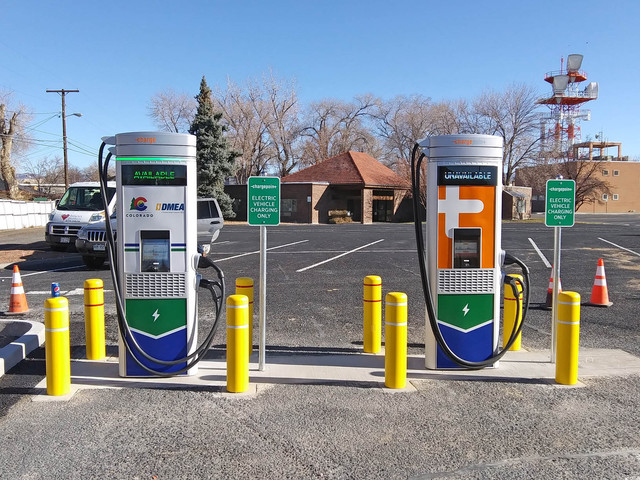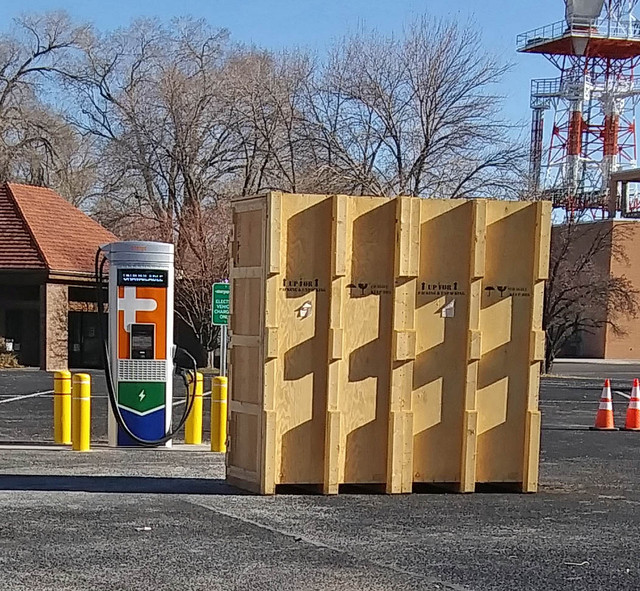GRA
Well-known member
Montrose and Estes Park are both showing as open on Plugshare and the CP app.

Hoping to head down and check Montrose in the next day or two (it is a 70 mile trip so I wait until I need groceries).GRA said:Montrose and Estes Park are both showing as open on Plugshare and the CP app.


20 cents/kWh for DC FC by CA standards wouldn't be bad but yeah, the 25 cents a minute on top of that is pretty crappy.dgpcolorado said:The rate is a stiff 20¢/kWh plus 25¢/min, an increasingly common rate in Colorado.
A technical note: that's not really how demand charges work. They are usually set by the highest power draw in any fifteen minute period in a month. So, if at any time the station draws the full 125 kW for fifteen minutes, that would set the demand charge at the maximum for the month. The actual DMEA proposed EV charge station tariff for three-phase stations of 50 kW or more:GRA said:...And the cars which will impose the highest demand charges will pay the least per kWh :roll:
Remember back when we were all taken aback by 70 cents a kWh in Europe at the Ionity chargers ?dgpcolorado said:The stalls "share" 125 kW so I presume that they are the usual 62.5 kW each. The rate is a stiff 20¢/kWh plus 25¢/min, an increasingly common rate in Colorado.
Yes. For those who don't have home charging, it also acts as an incentive to find and use cheaper L2 charging.SageBrush said:Remember back when we were all taken aback by 70 cents a kWh in Europe at the Ionity chargers ?
Slow charging EVs like the LEAF are not much cheaper
One silver lining though: people are going to learn to not charge much past a SoC of 60% if they do not need the charge to reach their next charging stop.
dgpcolorado said:<Snip>
Educating new EV road trippers to charge only enough to make the next stop, plus a reasonable buffer for something unexpected, such as a strong headwind, is going to be a long process. The ICE mentality of "fill it up" at fuel stops is going to be hard to break for many.
While I agree that 200 EPA is too little for easy road trips I've been doing them successfully with much less (my car has been at 178 EPA rated miles for the last several years and I have no trouble with 6000 mile road trips). A lot depends on the nav software (does it estimate battery percentage at destination in real time and is it reliable?) and driver experience. Tesla has had reliable nav software for years; how that will shake out for VW, GM, BMW, Ford and all the rest remains to be seen.GRA said:dgpcolorado said:<Snip>
Educating new EV road trippers to charge only enough to make the next stop, plus a reasonable buffer for something unexpected, such as a strong headwind, is going to be a long process. The ICE mentality of "fill it up" at fuel stops is going to be hard to break for many.
Of course, until the charging station density and their reliability radically improve, 'a reasonable buffer' may require an extra 70-120 miles worth of charge. If you're also unwilling to deplete your battery below say 20% SoC except in emergencies for longevity reasons, then as a practical matter you're limited to a maximum of just 60% (QC to 80%, reserve of 20%) of whatever the battery's usable capacity/range is at that time, before any allowance for conditions.
A nominal 200 mile HWY BEV thus has at best just 120 miles of usable range between QCs, considerably less after allowances. Subtract any degradation and you need to charge well over 80% of the remaining usable capacity, and you can forget keeping 'a reasonable buffer' to get you to the next station in most rural areas, given their current spacing.
dgpcolorado said:<Snip>
Your assumption of 20% as a lower limit to preserve the battery isn't reasonable. Occasionally going down to 5% or so is no big deal, as is charging to 100% just before setting out on a trip. Setting artificial limits on battery use to limit usable range is not reasonable for road trips. That's simply not how it works (nor should it). Keeping the battery in that 20% to 80% temperate zone for local driving is fine. So is using the whole battery on occasion when needed, so long as it isn't left at high or low charge.
dgpcolorado said:ChargePoint CCS/Chademo charging has opened in Steamboat Springs, Del Norte, and Fairplay. Prices are all over the map:
Del Norte, one stall (another coming? Says power is shared, also "power reduced"), Cost: "free"
Fairplay, two stalls at the Fairplay Visitor's Center, 20¢/kWh plus 25¢/minute
*Steamboat Springs, two stalls at Kum & Go, 20¢/kWh
*Montrose, two stalls, 20¢/kWh plus 25¢/minute
*Pagosa Springs, two stalls, 30¢/kWh
*Salida, two stalls, 20¢/kWh plus 20¢/minute
Buena Vista, one stall, 54.6¢/kWh from 10 PM to 4 PM, $1.329/kWh from 4 PM to 10 PM
Colorado Springs, one stall CCS only, free
Grand Junction, one stall at a Stop N Save, 25¢/kWh plus 10¢/min from 5 AM to 11 PM
*Dinosaur, two stalls, 20¢/kWh plus 25¢/minute
Meeker, one stall, 25¢/kWh
Carbondale, one stall, 14¢/kWh
Basalt, one stall, free
Crested Butte, one stall, 20¢/kWh plus 25¢/minute
Gypsum, two stalls at Eagle County Airport, 10¢/kWh
Eagle, one stall at the park and ride, 10¢/kWh
Edwards, one stall, 24¢/kWh from 12 AM to 4 PM, 75¢/kWh from 4 PM to 9 PM, free from 9 PM to 12 AM
Avon, one stall, free
As always: YMMV.
I believe that you are right about those but it is possible that some of the ones you marked were placed independent of the state charging corridors project (I don't care to research them since it really doesn't matter much). I do know that the Montrose station is part of the state project and it is marked as such on one of the stalls.GRA said:Just to avoid any confusion, while dgp's list are all Chargepoint stations, only the ones I've marked with an asterisk (think I got them all) are one of the of the state's 34 sites in their 6 electric vehicle fast charging corridors. The rest are independent of that, albeit useful, mainly off-interstate rural sites as many are...
dgpcolorado said:I believe that you are right about those but it is possible that some of the ones you marked were placed independent of the state charging corridors project (I don't care to research them since it really doesn't matter much). I do know that the Montrose station is part of the state project and it is marked as such on one of the stalls.GRA said:Just to avoid any confusion, while dgp's list are all Chargepoint stations, only the ones I've marked with an asterisk (think I got them all) are one of the of the state's 34 sites in their 6 electric vehicle fast charging corridors. The rest are independent of that, albeit useful, mainly off-interstate rural sites as many are...
Given that two ChargePoint stalls per site doesn't allow much redundancy, the more locations the better in the remote areas of the state. If a driver gets to Dinosaur and the two stalls are down, it could be a long day scrambling for "plan B"!
Enter your email address to join: